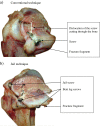Minimally invasive reconstruction of lateral tibial plateau fractures using the jail technique: a biomechanical study
- PMID: 23557098
- PMCID: PMC3640976
- DOI: 10.1186/1471-2474-14-120
Minimally invasive reconstruction of lateral tibial plateau fractures using the jail technique: a biomechanical study
Abstract
Background: This study described a novel, minimally invasive reconstruction technique of lateral tibial plateau fractures using a three-screw jail technique and compared it to a conventional two-screw osteosynthesis technique. The benefit of an additional screw implanted in the proximal tibia from the anterior at an angle of 90° below the conventional two-screw reconstruction after lateral tibial plateau fracture was evaluated. This new method was called the jail technique.
Methods: The two reconstruction techniques were tested using a porcine model (n = 40). Fracture was simulated using a defined osteotomy of the lateral tibial plateau. Load-to-failure and multiple cyclic loading tests were conducted using a material testing machine. Twenty tibias were used for each reconstruction technique, ten of which were loaded in a load-to-failure protocol and ten cyclically loaded (5000 times) between 200 and 1000 N using a ramp protocol. Displacement, stiffness and yield load were determined from the resulting load displacement curve. Failure was macroscopically documented.
Results: In the load-to-failure testing, the jail technique showed a significantly higher mean maximum load (2275.9 N) in comparison to the conventional reconstruction (1796.5 N, p < 0.001). The trend for better outcomes for the novel technique in terms of stiffness and yield load did not reach statistical significance (p > 0.05). In cyclic testing, the jail technique also showed better trends in displacement that were not statistically significant. Failure modes showed a tendency of screws cutting through the bone (cut-out) in the conventional reconstruction. No cut-out but a bending of the lag screws at the site of the additional third screw was observed in the jail technique.
Conclusions: The results of this study indicate that the jail and the conventional technique have seemingly similar biomechanical properties. This suggests that the jail technique may be a feasible alternative to conventional screw osteosynthesis in the minimally invasive reconstruction of lateral tibial plateau fractures. A potential advantage of the jail technique is the prevention of screw cut-outs through the cancellous bone.
Figures




Similar articles
-
The effect of screw thread length on initial stability of Schatzker type 1 tibial plateau fracture fixation: a biomechanical study.J Orthop Surg Res. 2016 Nov 22;11(1):146. doi: 10.1186/s13018-016-0484-9. J Orthop Surg Res. 2016. PMID: 27876042 Free PMC article.
-
Plate osteosynthesis combined with bone cement provides the highest stability for tibial head depression fractures under high loading conditions.Sci Rep. 2022 Sep 14;12(1):15481. doi: 10.1038/s41598-022-19107-6. Sci Rep. 2022. PMID: 36104462 Free PMC article.
-
Biomechanical comparison of fixation of type-I fractures of the lateral tibial plateau. Is the antiglide screw effective?J Bone Joint Surg Br. 1999 May;81(3):478-80. doi: 10.1302/0301-620x.81b3.9100. J Bone Joint Surg Br. 1999. PMID: 10872370
-
Suture versus screw fixation technique for tibial eminence fracture: A meta-analysis of laboratory studies.J Orthop Surg (Hong Kong). 2020 Jan-Apr;28(1):2309499020907977. doi: 10.1177/2309499020907977. J Orthop Surg (Hong Kong). 2020. PMID: 32124674
-
[Tibial head fracture open reposition and osteosynthesis--arthroscopic reposition and osteosynthesis (ARIF)].Unfallchirurg. 2006 Mar;109(3):235-44. doi: 10.1007/s00113-006-1067-8. Unfallchirurg. 2006. PMID: 16523281 Review. German. No abstract available.
Cited by
-
Loading capacity of dynamic knee spacers: a comparison between hand-moulded and COPAL spacers.BMC Musculoskelet Disord. 2019 Dec 21;20(1):613. doi: 10.1186/s12891-019-2982-5. BMC Musculoskelet Disord. 2019. PMID: 31864332 Free PMC article.
-
Biomechanical evaluation of different surgical techniques for treating patellar tendon ruptures.Int Orthop. 2016 Aug;40(8):1717-1723. doi: 10.1007/s00264-015-3003-4. Epub 2015 Oct 3. Int Orthop. 2016. PMID: 26432575
-
Treatment of Isolated Posterolateral Tibial Plateau Fracture with a Horizontal Belt Plate through the Anterolateral Supra-Fibular-Head Approach.Biomed Res Int. 2020 Dec 3;2020:4186712. doi: 10.1155/2020/4186712. eCollection 2020. Biomed Res Int. 2020. PMID: 33344635 Free PMC article.
-
Comparison of the intraarticular osteotomy and the "window" osteotomy in the treatment of tibial plateau fracture involving depressed posterolateral fragments.BMC Musculoskelet Disord. 2023 Aug 30;24(1):694. doi: 10.1186/s12891-023-06803-1. BMC Musculoskelet Disord. 2023. PMID: 37649090 Free PMC article.
-
Reconstruction of the lateral tibia plateau fracture with a third triangular support screw: A biomechanical study.J Orthop Translat. 2017 Jan 3;11:30-38. doi: 10.1016/j.jot.2016.12.002. eCollection 2017 Oct. J Orthop Translat. 2017. PMID: 29662767 Free PMC article.
References
-
- Holz U. Causes, forms and concomitant injuries of the tibial head fractures. Hefte Unfallheilkd. 1975;120:99–113. - PubMed
MeSH terms
LinkOut - more resources
Full Text Sources
Other Literature Sources
Medical

